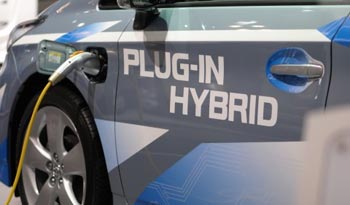Feb 10 2016
Plug-in hybrid electric vehicles (PHEVs) can reduce fuel consumption and greenhouse gas emissions compared to their gas-only counterparts. Researchers at the University of California, Riverside’s Bourns College of Engineering have taken the technology one step further, demonstrating how to improve the efficiency of current PHEVs by almost 12 percent.
 Researchers at the University of California, Riverside have shown how to improve the efficiency of current PHEVs.
Researchers at the University of California, Riverside have shown how to improve the efficiency of current PHEVs.
Since plug-in hybrids combine gas or diesel engines with electric motors and large rechargeable batteries, a key component is an energy management system (EMS) that controls when they switch from ‘all-electric’ mode, during which stored energy from their batteries is used, to ‘hybrid’ mode, which utilizes both fuel and electricity. As new EMS devices are developed, an important consideration is combining the power streams from both sources in the most energy-efficient way.
While not all plug-in hybrids work the same way, most start in all-electric mode, running on electricity until their battery pack is depleted and then switching to hybrid mode. Known as binary mode control, this EMS strategy is easy to apply, but isn’t the most efficient way to combine the two power sources. In lab tests, blended discharge strategies, in which power from the battery is used throughout the trip, have proven to be more efficient at minimizing fuel consumption and emissions, but until now they haven’t been a realistic option for real-world applications, said Xuewei Qi, a graduate student in the Bourns College of Engineering’s Center for Environmental Research and Technology (CE-CERT) who led the research. Qi is working with CE-CERT Director Matthew Barth, a professor of electrical and computer engineering.
“Blended discharge strategies have the ability to be extremely energy efficient, but those proposed previously require upfront knowledge about the nature of the trip, road conditions and traffic information, which in reality is almost impossible to provide,” Qi said.
While the UCR EMS does require trip-related information, it also gathers data in real time using onboard sensors and communications devices, rather than demanding it upfront. It is one of the first systems based on a machine learning technique called reinforcement learning (RL), and was published online Feb. 5 in the journal Transportation Research Record.
In comparison-based tests on a 20-mile commute in Southern California, the UCR EMS outperformed currently available binary mode systems, with average fuel savings of 11.9 percent. Even better, Qi said, the system gets smarter the more it’s used and is not model- or driver-specific, meaning it can be applied to any PHEV driven by any individual.
“In our reinforcement learning system, the vehicle learns everything it needs to be energy efficient based on historical data. As more data are gathered and evaluated, the system becomes better at making decisions that will save on energy,” Qi said.
Qi said the next phase of the research will focus on creating a cloud-based network that enables PHEVs to work together for even better results.
“Our current findings have shown how individual vehicles can learn from their historical driving behavior to operate in an energy efficient manner. The next step is to extend the proposed mode to a cloud-based vehicle network where vehicles not only learn from themselves but also each other. This will enable them to operate on even less fuel and will have a huge impact on the amount of greenhouse gases and other pollutants released,” he said.
The work was done by Qi and Barth, together with Guoyuan Wu, assistant research engineer at CE-CERT; Kanok Boriboonsomsin, associate research engineer at CE-CERT; and Jeffrey Gonder, senior engineer at the National Renewable Energy Laboratory in Golden, Colo. The project was partially supported by the U. S. Department of Transportation.
The UCR Office of Technology Commercialization has filed patents for the inventions above.